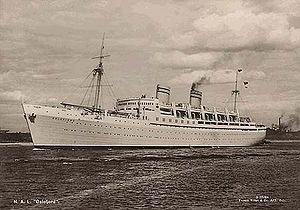MS Oslofjord (1937)

| |
| History | |
|---|---|
| Name | Oslofjord |
| Operator | Norwegian America Line |
| Port of registry | Oslo |
| Builder | Deutsche Schiff- und Maschinenbau, Bremen |
| Launched | 29 December 1937 |
| Acquired | May 1938 |
| Fate | Sunk 1941 |
| General characteristics | |
| Tonnage | 18,673 GRT |
| Length | 179.20 m (587 ft 11 in) |
| Beam | 22 m (72 ft 2 in) |
| Draught | 10.40 m (34 ft 1 in) |
| Installed power | 2 x MAN diesel engines |
| Capacity | 860 passengers |
MS Oslofjord was an ocean liner built in 1938 by A/G Weser Shipbuilders, Bremen, Germany, for Norwegian America Line. She was of 18,673 gross register tons, and could carry 860 passengers.
On 27 April 1939, Oslofjord collided with the American 160-foot (48.8 m) pilot boat Sandy Hook in the North Atlantic Ocean west of Sandy Hook, New Jersey, off the Ambrose Lightship at 40°27.556′N 073°49.490′W / 40.459267°N 73.824833°W. Sandy Hook sank in 100 feet (30 m) of water, and Oslofjord rescued all 26 crew members and harbor pilots on board Sandy Hook.[1][2]
During World War II, Oslofjord sank after just two years of service on the night of 21-22 January 1941 after hitting a mine in the North Sea off the coast of England off the River Tyne on 1 December 1940.[3][4] Her wreck lies in 15 metres (49 ft) of water at 55°0.17′N 1°23.72′W / 55.00283°N 1.39533°WCoordinates: 55°0.17′N 1°23.72′W / 55.00283°N 1.39533°W.
References[]
- ^ "Casualty Reports". The Times (48291). London. 28 April 1939. col C, p. 29.
- ^ njscuba.net Sandy Hook - Pilot Boat
- ^ Lawson, Siri Holm. "M/S Oslofjord". Warsailors.com. Retrieved 24 January 2010.
- ^ Miller, William H. Jr. (1995). Pictorial Encyclopedia of Ocean Liners, 1860-1994. New York: Dover Publications. pp. 92. ISBN 0-486-28137-X.
External links[]
- Ocean liners
- Passenger ships of Norway
- Norwegian America Line
- World War II shipwrecks in the North Sea
- Maritime incidents in 1939
- Maritime incidents in December 1940
- Maritime incidents in January 1941
- Ships built in Bremen (state)
- Wreck diving sites in England
- Ships sunk by mines
- 1941 in England
- Individual ship or boat stubs
 WikiMiniAtlas
WikiMiniAtlas